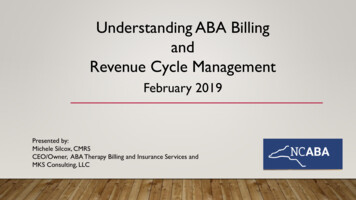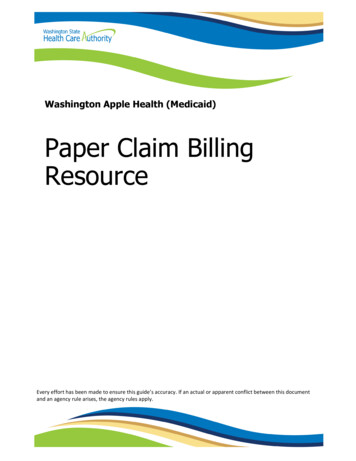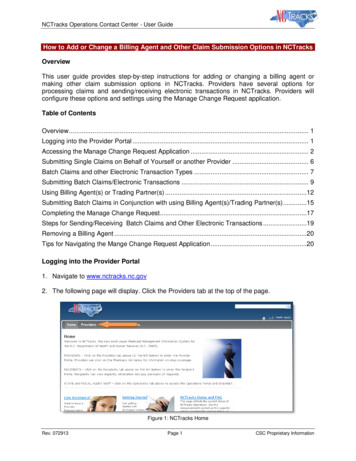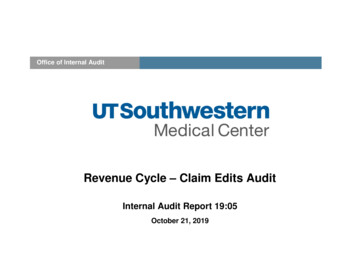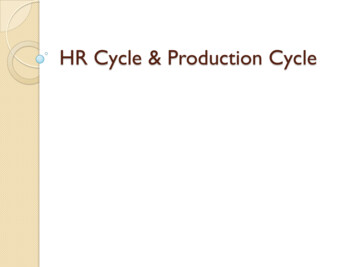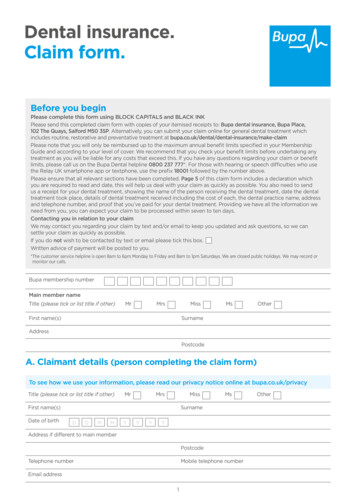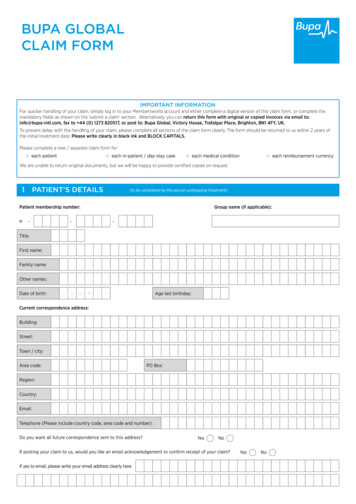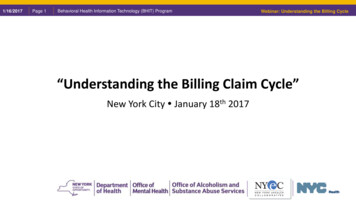
Transcription
1/16/2017Page 1Behavioral Health Information Technology (BHIT) ProgramWebinar: Understanding the Billing Cycle“Understanding the Billing Claim Cycle”New York City January 18th 2017
1/16/2017Page 2Behavioral Health Information Technology (BHIT) ProgramWebinar: Understanding the Billing CycleWebinar contentBasic ConceptsClaimsGeneration &TransmissionClaimsProcessingBilling Claim CycleClaimsAdjudication
1/16/2017Page 3 Behavioral Health Information Technology (BHIT) ProgramBehavioral HealthWebinar:InformationTechnology the(BHIT)ProgramUnderstandingBillingCycleTarget AudienceThis webinar is intended for organizations: Which are currently using paper for documenting and/or billing Which have a very limited or no billing experience at all Require to have a basic understanding of the claim processing
1/16/2017Page 4Behavioral Health Information Technology (BHIT) ProgramBasic ConceptsWebinar: Understanding the Billing Cycle
1/16/2017Page 5 Behavioral Health Information Technology (BHIT) ProgramBehavioral HealthWebinar:InformationTechnology the(BHIT)ProgramUnderstandingBillingCycleBasic Concepts EBS: Electronic Billing System Software used ONLY for claim processing. Usually includes some demographics,billing and reporting capabilities EMR: Electronic Medical Record Software which allows ONLY case documentation for medical or behavioralhealthcare. It does not have billing functionalities EHR: Electronic Health Record Software which allows case documentation and billing, all integrated within thesame system
1/16/2017Page 6 Behavioral Health Information Technology (BHIT) ProgramBehavioral HealthWebinar:InformationTechnology the(BHIT)ProgramUnderstandingBillingCycleBasic Concepts HMO: Health Maintenance Organization e.g., Oxford Health Users should go to a designated network of providers Users are only responsible for co-payment PPO: Preferred Provider Organization Users can choose providers In-the-Network or Out-of-the-Network If chosen In-the-Network: Users are only responsible for co-payment If chosen Out-of-the-Network: Users should pay a percentage
1/16/2017Page 7 Behavioral Health Information Technology (BHIT) ProgramBehavioral HealthWebinar:InformationTechnology the(BHIT)ProgramUnderstandingBillingCycleBasic Concepts POS: Point of Service Similar to PPO Except that users are usually required for: Co-payment Co-Insurance: where the plans pays a percentage and the difference is paid bythe user Indemnity: There is NO-Network Users can choose any provider, anywhere Plans pays a percentage – User pays the difference
1/16/2017Page 8 Behavioral Health Information Technology (BHIT) ProgramBehavioral HealthWebinar:InformationTechnology the(BHIT)ProgramUnderstandingBillingCycleBasic Concepts NF (No Fault): Medical services due to automobile accident WC (Worker Compensation): Compensation after being hurt at work Regular Medicaid or Straight Medicaid:Government insurance for who needs financial assistance (adults and children) Medicaid Managed Care Organizations:Commercial/Private Insurance Carriers which had been outsourced byMedicaid to handle specific services.
1/16/2017Page 9 Behavioral Health Information Technology (BHIT) ProgramBehavioral HealthWebinar:InformationTechnology the(BHIT)ProgramUnderstandingBillingCycleBasic Concepts Fee schedule: Approved conditions by CMS which regulates healthcareservices and payment CPT (Current Procedure Terminology): Procedures and service codes ICD10: Diagnosis code (R69 only code for ALL HCBS services) Rate code: Amount of reimbursement for the service Modifier: Conditional details of the Procedural Code which might affectthe Rate Code (e.g., Onsite vs Offsite; Individual vs Group)
1/16/2017Page 10Behavioral Health Information Technology (BHIT) ProgramBehavioral HealthWebinar:InformationTechnology the(BHIT)ProgramUnderstandingBillingCycleBasic Concepts HCFA1500/CMS1500 Health Care Financial Administration Form 1500 or CMS1500: Center forMedicaid/Medicare Services Form 1500 Paper forms used for submit claims Used for professional staff onlyPaperElectronic UB04: Paper form used for submit claims Used by OrganizationsProfessionalServicesInstitutional &OrganizationalHCFA1500 orCMS1500837pUB04837i
1/16/2017Page 11Behavioral Health Information Technology (BHIT) ProgramClaims Generation &TransmissionWebinar: Understanding the Billing Cycle
1/16/2017Page 12Behavioral Health Information Technology (BHIT) ProgramService isdeliveredService isdocumentedBehavioral HealthWebinar:InformationTechnology the(BHIT)ProgramUnderstandingBillingCycleService isapproved forclaimService deliveryClaim Batch iscreatedClaim Batch FileClaim BatchReportClaims generationClaimsScrubbingClaimsTransmitted toPayerClaimsTransmissionReportClaims Transmission to the Payer
1/16/2017Page 13Behavioral Health Information Technology (BHIT) ProgramBehavioral HealthWebinar:InformationTechnology the(BHIT)ProgramUnderstandingBillingCycleBasic concepts about claims . Claim batch: Process that allows to consolidate multiple claims into a claim batch which will beready to be sent for transmission Claim batch file: Text file which consolidates multiple claims and transmitted to the payer. Claim batch report: Detailed report of the data or information that is contained into the Claim BatchFile
1/16/2017Page 14Behavioral Health Information Technology (BHIT) ProgramBehavioral HealthWebinar:InformationTechnology the(BHIT)ProgramUnderstandingBillingCycleClaims Scrubbing and Transmission Claims Scrubbing: Internal process in the software which reviews the claims in order to reduceerrors before transmitting to the payer Transmission Report: List ALL claims: Transmitted and RejectedIn theory the total number of the Claim Batch Report should be equal to theTransmission Report.If not matched it is due to Claims Scrubbing
1/16/2017Page 15Behavioral Health Information Technology (BHIT) ProgramBehavioral HealthWebinar:InformationTechnology the(BHIT)ProgramUnderstandingBillingCycleClaim transmission to the Payer Two modalities: Payer direct Clearinghouse: Intermediate organization which receives transmitted claim filesand forward them to the proper payer Clearinghouses: Some carriers only accept claims from a clearinghouse Clearinghouses do additional scrubbing utilizing Correct Coding Initiative (CCI) Edits CCI gets into more details of the rules for the claims. Internal scrubbing usuallyfocuses on data existing in the claim (missing or not)With the warning alerts we have somewhat eliminating the need of the CCI
1/16/2017Page 16Behavioral Health Information Technology (BHIT) ProgramBehavioral HealthWebinar:InformationTechnology the(BHIT)ProgramUnderstandingBillingCycleClaim transmission to the Payer More about Clearinghouses: Not freeReports are usually generated within 24 hours after transmissionReports included accepted and rejected claimsIf rejected it always indicates error (e.g., incorrect diagnosis or modifier) or whereto look
1/16/2017Page 17Behavioral Health Information Technology (BHIT) ProgramClaims Processing byPayerWebinar: Understanding the Billing Cycle
Page 18Behavioral Health Information Technology (BHIT) Program837i isreceived fromProviderAdditionalScrubbingBehavioral HealthWebinar:InformationTechnology 16/2017DeterminationClaims Processing by PayerClaim RemitFile
1/16/2017Page 19Behavioral Health Information Technology (BHIT) ProgramBehavioral HealthWebinar:InformationTechnology the(BHIT)ProgramUnderstandingBillingCycleClaims processing by Payer Receives Claims Batch File (837i) Transmitted by software or clearinghouse Uploaded into the carrier’s system: Performs additional claims scrubbing: e.g.: Policy Number (17 versus 71) Processes valid claims Takes claims information Determine if payable or not If Payable determine amount If not payable, provides explanation of why is not payable
1/16/2017Page 20Behavioral Health Information Technology (BHIT) ProgramBehavioral HealthWebinar:InformationTechnology the(BHIT)ProgramUnderstandingBillingCycleClaims processing by Payer Generates report of results Process approximately takes 15 to 20 days from the time of transmission to thetime of receiving response from the carrier (range 7 -30 days) Usually response is electronic and it is called Claim Remit File or Explanation ofBenefits (EOB) After being received by provider software results are being posted to theindividual chart. This is called automatic posting or auto-post
1/16/2017Page 21Behavioral Health Information Technology (BHIT) ProgramBehavioral HealthWebinar:InformationTechnology the(BHIT)ProgramUnderstandingBillingCycleHow to read the Claim Remit File/EOB IF claim is PAID Member IdentificationCharges: Fees for services providedApproved: Fee amount that the carrier is willing to payPayment: Net payment paid by the carrier (direct deposit; check)Co-Insurance: Percentage of the approved amount that the member should paid.Usually applies for providers out of the network Patient Responsibility: Dollar amount that the member should pay to the provider Co-pay: Fixed amount that the member should pay. Usually applies for providerswithin the networkFor HCBS Customers: The last three above will be blank
1/16/2017Page 22Behavioral Health Information Technology (BHIT) ProgramBehavioral HealthWebinar:InformationTechnology the(BHIT)ProgramUnderstandingBillingCycleHow to read the Claim Remit File/EOB IF claim is REJECTED In addition to the information of previous slide Denial Reason Code (DRC): Coded in alpha or numeric which explains why the claims was not being paid For example: Code 18 (Duplicate claim) DRC for Straight Medicaid/Medicare are standardized DRC for Commercial/Medicaid MCOs are not standardized
1/16/2017Page 23Behavioral Health Information Technology (BHIT) ProgramBehavioral HealthWebinar:InformationTechnology the(BHIT)ProgramUnderstandingBillingCycleHow to APPEAL a rejected Claim Deadline for appeals differs by each carrier/payer Proceed to appeal no later than 30 days after the date of rejection Method: Written letter plus attachments It should be sent via regular mail DO not send via email for HIPAA Regulations
1/16/2017Page 24Behavioral Health Information Technology (BHIT) ProgramClaims AdjudicationWebinar: Understanding the Billing Cycle
1/16/2017Page 25Behavioral Health Information Technology (BHIT) ProgramBehavioral HealthWebinar:InformationTechnology the(BHIT)ProgramUnderstandingBillingCycleClosing the claim cycle Auto post payment: Remit file is instantaneously uploaded into each individual electronic chart What should be the balance? When Payment Balance equals ZERO then claims payment is closed One penny difference does not close the claim and leads the organization toWrite Offs Write Offs Organizational decision to reduce or charge the patient from remaining balances. The agency can charge the patient only what the carrier has indicated in thecolumn of Patient Responsibility
1/16/2017Page 26Behavioral Health Information Technology (BHIT) ProgramBehavioral HealthWebinar:InformationTechnology the(BHIT)ProgramUnderstandingBillingCycleHow do I follow up on my claims? Balance Report: At the end of each day is important to run a report of all charges, adjustmentsand payments We suggest you match the payment total with the deposit total Account Receivables (AR) Report Lists status of balance of pending payments Age Trial balance Report Same AR report but with the additional information of how long the balance hasexisted e.g., 30 days; 30-60 days; 60-90 days; 90 days
1/16/2017Page 27Behavioral Health Information Technology (BHIT) ProgramBehavioral HealthWebinar:InformationTechnology the(BHIT)ProgramUnderstandingBillingCycleBHIT TeamNew York e-Health Collaborative (NYeC) - ROSSharon BariPhone646- 619.6503emailsbari@nyehealth.orgDepartment of Health and Mental Hygiene - NYCElise nyc.govOMHEric WeiskopfPhoneemailErica lth.orgAlexandra ovProgrammaticDoug .ny.govTechnical TeamMitch id arina yc.govHector ko IkutaPhoneemail(518) @health.nyc.govLisa nn@oasas.ny.gov
1/16/2017Page 28Behavioral Health Information Technology (BHIT) ProgramBehavioral HealthWebinar:InformationTechnology the(BHIT)ProgramUnderstandingBillingCycleMany thanks foryour attendance !!!
EBS: Electronic Billing System Software used ONLY for claim processing. Usually includes some demographics, billing and reporting capabilities EMR: Electronic Medical Record Software which allows ONLY case documentation for medical or behavioral healthcare. It does not have billing functionalities EHR: Electronic Health RecordFile Size: 1MBPage Count: 28
